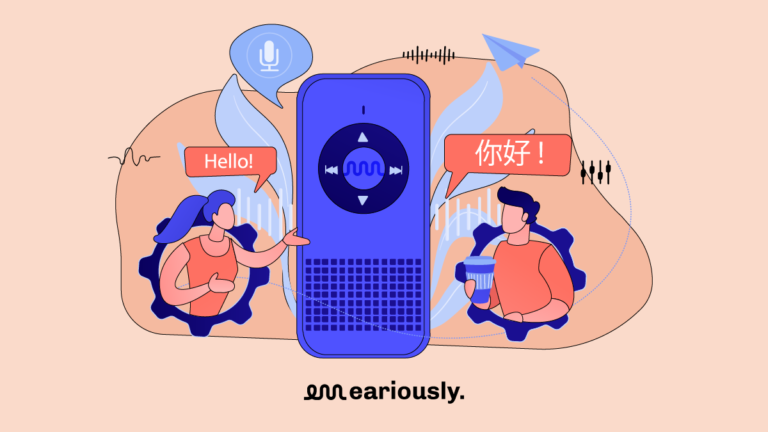In today’s globalized world, the ability to effectively communicate across language barriers is increasingly important. Text-to-speech (TTS) technology is helping to bridge these linguistic gaps and provide a more seamless way to communicate. This blog post will explore how TTS technology is providing a means of collaboration and understanding between people, regardless of the language they speak. TTS enables users to communicate across language barriers in a more natural, efficient, and cost-effective way. Through the advances in speech synthesis, users can enjoy a smooth, natural-sounding voice, better pronunciation, and more accurate translation of words and phrases. So, let’s take a deeper look at how TTS can bridge linguistic barriers and open up a world of possibilities
What Makes Text-to-speech a Bridge to Linguistic Barriers?

Text-to-speech technology has the potential to bridge linguistic barriers and make written content more accessible to a global audience. By converting written text into spoken words, text-to-speech can help people from different linguistic backgrounds understand and engage with written content. This can be especially useful for learners who are learning a new language, as text-to-speech can provide an audio version of written content that they can listen to and understand. In addition, text-to-speech can be used to translate written content into different languages, making it more accessible to a global audience.
Benefits of Text-to-speech for Language Translation
With TTS, our ability to communicate with each other and collaborate across language barriers has never been greater. So let’s go ahead and take a look at the benefits of text-to-speech for language translation.
It Improves Listening and Pronunciation Skills
One of the main benefits of text-to-speech for language learners is the ability to improve listening and pronunciation skills. By listening to text-to-speech audio, learners can become more familiar with the rhythms and sounds of the language they are learning, which can help them improve their pronunciation. In addition, text-to-speech can be used to provide audio versions of texts that are difficult to understand or that contain complex grammar or vocabulary. By providing an audio option for these texts, text-to-speech can help learners understand and retain the material more effectively.
It Helps by Translating Written Content into Different Languages
Text-to-speech can also be a valuable tool for educators who are teaching languages to a diverse group of students. By using text-to-speech to create audio versions of written content, educators can make their materials more accessible and engaging for learners from different linguistic backgrounds. Text-to-speech can also be used to create interactive quizzes and assessments that allow learners to practice their listening and pronunciation skills. By providing a range of audio and interactive options, text-to-speech can make language learning more engaging and effective for a diverse group of learners.
It Provides an Audio Option for Difficult Texts
Text-to-speech technology can provide an audio option for texts that are difficult to understand or that contain complex grammar or vocabulary. By converting written text into spoken words, text-to-speech can help learners understand and retain difficult material more effectively. This can be especially useful for learners who are learning a new language, as they may struggle to understand written texts that contain complex grammar or vocabulary. By providing an audio option for these texts, text-to-speech can help learners become more familiar with the rhythms and sounds of the language they are learning, which can improve their understanding and retention of the material.
In addition to its benefits for language learners, text-to-speech can also be useful for individuals who have reading disabilities or visual impairments. By providing an audio option for written content, text-to-speech can help these individuals access and understand written materials that may otherwise be difficult or impossible for them to read. This can be especially valuable for students who are taking online courses or engaging with other types of written content, as it can provide an alternative to reading that allows them to absorb and retain the material more effectively.
It Has the Potential to Create Interactive Quizzes and Assessments
We should consider the potential for text-to-speech to create interactive quizzes and assessments that allow learners to practice their listening and pronunciation skills for several reasons. First, these types of quizzes and assessments can be valuable tools for language learners, as they provide an opportunity to practice and improve listening and pronunciation skills more interactively and engagingly.
And as it is mentioned above, by using text-to-speech to create audio versions of quizzes and assessments, educators can create a more dynamic and interactive learning experience for their students. To create quizzes, you can use easy-to-use software like Quiz Maker.
In addition to its benefits for language learners, text-to-speech can also be useful for individuals who are learning a new subject or skill and need to practice their listening and comprehension skills. By creating interactive quizzes and assessments that use text-to-speech audio, educators can provide a more engaging and interactive way for learners to test their knowledge and skills.
Wrapping Up
In conclusion, text-to-speech technology is emerging as a game-changer for bridging the linguistic divide. There are numerous more benefits of using text-to-speech for language translation. It helps people communicate across cultures and languages, allowing for better understanding and collaboration. Moreover, its use of machine learning algorithms makes it flexible and adaptable to different languages, accents, and dialects. Shortly, text-to-speech technology may become an integral part of the global communication landscape.
So try Eariously for free today and start creating custom voiceovers for your brand!





